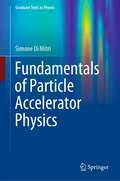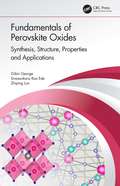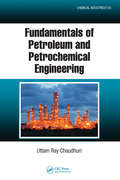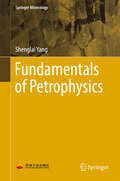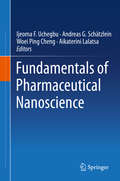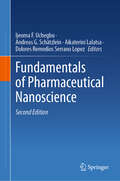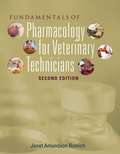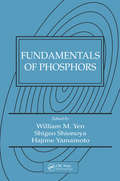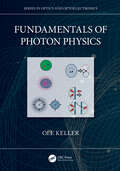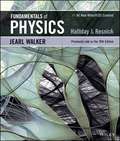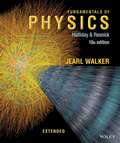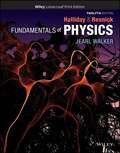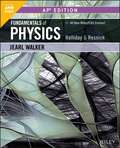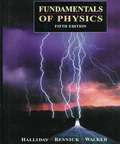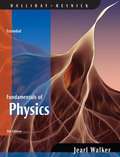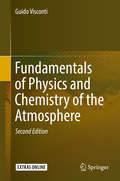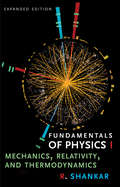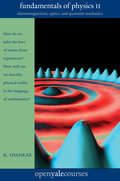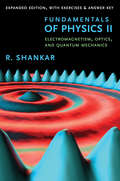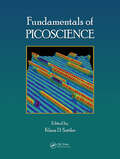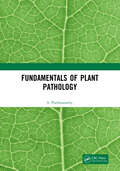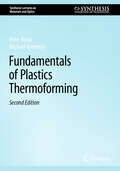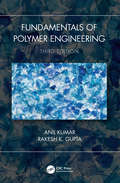- Table View
- List View
Fundamentals of Particle Accelerator Physics (Graduate Texts in Physics)
by Simone Di MitriThis book offers a concise and coherent introduction to accelerator physics and technology at the fundamental level but still in connection to advanced applications ranging from high-energy colliders to most advanced light sources, i.e., Compton sources, storage rings and free-electron lasers. The book is targeted at accelerator physics students at both undergraduate and graduate levels, but also of interest also to Ph.D. students and senior scientists not specialized in beam physics and accelerator design, or at the beginning of their career in particle accelerators.The book introduces readers to particle accelerators in a logical and sequential manner, with paragraphs devoted to highlight the physical meaning of the presented topics, providing a solid link to experimental results, with a simple but rigorous mathematical approach. In particular, the book will turn out to be self-consistent, including for example basics of Special Relativity and Statistical Mechanics for accelerators. Mathematical derivations of the most important expressions and theorems are given in a rigorous manner, but with simple and immediate demonstration where possible.The understanding gained by a systematic study of the book will offer students the possibility to further specialize their knowledge through the wide and up-to-date bibliography reported. Both theoretical and experimental items are presented with reference to the most recent achievements in colliders and light sources. The author draws on his almost 20-years long experience in the design, commissioning and operation of accelerator facilities as well as on his 10-years long teaching experience about particle accelerators at the University of Trieste, Department of Engineering and of Physics, as well as at international schools on accelerator physics.
Fundamentals of Perovskite Oxides: Synthesis, Structure, Properties and Applications
by Gibin George Sivasankara Rao Ede Zhiping LuoThis textbook entitled Fundamentals of Perovskite Oxides: Synthesis, Structure, Properties and Applications summarizes the structure, synthesis routes, and potential applications of perovskite oxide materials. Since these perovskite-type ceramic materials offer opportunities in a wide range of fields of science and engineering, the chapters are broadly organized into four sections of perovskite-type oxide materials and technology. Covers recent developments in perovskite oxides Serves as a quick reference of perovskite oxides information Describes novel synthesis routes for nanostructured perovskites Discusses comprehensive details for various crystal structures, synthesis methods, properties, and applications Applies to academic education, scientific research, and industrial R&D for materials research in real-world applications like bioengineering, catalysis, energy conversion, energy storage, environmental engineering, and data storage and sensing This book serves as a handy and practical guideline suitable for students, engineers, and researchers working with advanced ceramic materials.
Fundamentals of Petroleum and Petrochemical Engineering (Chemical Industries)
by Uttam Ray ChaudhuriThe supply of petroleum continues to dwindle at an alarming rate, yet it is the source of a range of products- from gasoline and diesel to plastic, rubber, and synthetic fiber. Critical to the future of this commodity is that we learn to use it more judiciously and efficiently. Fundamentals of Petroleum and Petrochemical Engineering provides a holi
Fundamentals of Petrophysics (Springer Mineralogy)
by Shenglai YangIn this book, the fundamental knowledge involved in petroleum & gas development engineering, such as physical and chemical phenomena, physical processes and the relationship between physical factors is covered. It is arranged into 3 Sections. Section 1 including chapter 1-4 is to introduce the properties of fluids (gases, hydrocarbon liquids, and aqueous solutions). Section II including Chapter 5-7 is to introduce the porous rock properties of reservoir rocks. Section III including Chapter 8-10 is to introduce the mechanism of multiphase fluid flow in porous medium. The book is written primarily to serve professionals working in the petroleum engineering field. It can also be used as reference book for postgraduate and undergraduate students as well for the related oil fields in petroleum geology, oil production engineering, reservoir engineering and enhancing oil recovery.
Fundamentals of Pharmaceutical Nanoscience
by Ijeoma F. Uchegbu Andreas G. Schätzlein Woei Ping Cheng Aikaterini LalatsaNanoscience or the science of the very small offers the pharmaceutical scientist a wealth of opportunities. By fabricating at the nanoscale, it is possible to exert unprecedented control on drug activity. This textbook will showcase a variety of nanosystems working from their design and construction to their application in the field of drug delivery. The book is intended for graduate students in drug delivery, physical and polymer chemistry, and applied pharmaceutical sciences courses that involve fundamental nanoscience. The purpose of the text is to present physicochemical and biomedical properties of synthetic polymers with an emphasis on their application in polymer therapeutics i. e. , pharmaceutical nanosystems, drug delivery and biological performance. There are two main objectives of this text. The first is to provide advanced graduate students with knowledge of the principles of nanosystems and polymer science including synthesis, structure, and characterization of solution and solid state properties. The second is to describe the fundamentals of therapeutic applications of polymers in drug delivery, targeting, response modifiers as well as regulatory issues. The courses, often listed as Advanced Drug Delivery and Applied Pharmaceutics; Polymer Therapeutics; or Nanomedicine, are designed as an overview of the field specifically for graduate students in the Department of Pharmaceutical Sciences Graduate Programs. However, the course content may also be of interest for graduate students in related biomedical research programs. These courses generally include a discussion of the major principles of polymer science and fundamental concepts of application of polymers as modern therapeutics. All courses are moving away from the above mentioned course names and going by 'pharmaceutical nanoscience or nanosystems'. This area of research and technology development has attracted tremendous attention during the last two decades and it is expected that it will continue to grow in importance. However, the area is just emerging and courses are limited but they are offered.
Fundamentals of Pharmaceutical Nanoscience
by Ijeoma F. Uchegbu Andreas G. Schätzlein Aikaterini Lalatsa Dolores Remedios Serrano LopezNanoscience or the science of the very small offers the pharmaceutical scientist a wealth of opportunities. By fabricating at the nanoscale, it is possible to exert unprecedented control on drug activity. This textbook will showcase a variety of nanosystems working from their design and construction to their application in the field of drug delivery. The book is intended for graduate students in drug delivery, physical and polymer chemistry, and applied pharmaceutical sciences courses that involve fundamental nanoscience. The purpose of the text is to present physicochemical and biomedical properties of synthetic polymers with an emphasis on their application in polymer therapeutics i.e., pharmaceutical nanosystems, drug delivery and biological performance. There are two main objectives of this text. The first is to provide advanced graduate students with knowledge of the principles of nanosystems and polymer science including synthesis, structure, and characterization of solution and solid state properties. The second is to describe the fundamentals of therapeutic applications of polymers in drug delivery, targeting, response modifiers as well as regulatory issues. The courses, often listed as Advanced Drug Delivery and Applied Pharmaceutics; Polymer Therapeutics; or Nanomedicine, are designed as an overview of the field specifically for graduate students in the Department of Pharmaceutical Sciences Graduate Programs. However, the course content may also be of interest for graduate students in related biomedical research programs. These courses generally include a discussion of the major principles of polymer science and fundamental concepts of application of polymers as modern therapeutics. All courses are moving away from the above mentioned course names and going by ‘pharmaceutical nanoscience or nanosystems’. This area of research and technology development has attracted tremendous attention during the last twodecades and it is expected that it will continue to grow in importance. However, the area is just emerging and courses are limited but they are offered.
Fundamentals of Pharmacology for Veterinary Technicians (2nd Edition)
by Janet Amundson RomichBuild a strong foundation for understanding how medications may help or potentially harm animals. FUNDAMENTALS OF PHARMACOLOGY FOR VETERINARY TECHNICIANS, 2E, follows a body-systems approach making it easy to correlate basic anatomy and physiology with the drugs used to treat diseases of each body system. A strong foundation of drug administration, pharmacokinetics, measurement systems, as well as drug approval and safety provides the concepts necessary to understand drug actions and safe drug administration. A StudyWARETM CD-ROM accompanies the book which provides additional practice via quizzes or games.
Fundamentals of Phosphors
by William M. Yen, Shigeo Shionoya and Hajime YamamotoDrawing from the second edition of the best-selling Handbook of Phosphors, Fundamentals of Phosphors covers the principles and mechanisms of luminescence in detail and surveys the primary phosphor materials as well as their optical properties. The book addresses cutting-edge developments in phosphor science and technology including oxynitride phosphors and the impact of lanthanide level location on phosphor performance.Beginning with an explanation of the physics underlying luminescence mechanisms in solids, the book goes on to interpret various luminescence phenomena in inorganic and organic materials. This includes the interpretation of the luminescence of recently developed low-dimensional systems, such as quantum wells and dots. The book also discusses the excitation mechanisms by cathode-ray and ionizing radiation and by electric fields to produce electroluminescence. The book classifies phosphor materials according to the type of luminescence centers employed or the class of host materials used and interprets the optical properties of these materials, including their luminescence characteristics and mechanisms. Placing a strong emphasis on those materials that are important from a practical point of view, the coverage also includes those possessing no possibility for practical use but are important from a theoretical standpoint.
Fundamentals of Photon Physics (Series in Optics and Optoelectronics)
by Ole KellerThe photon, an abstract concept belonging to a global vacuum, only manifests itself duringinteraction with matter. Fundamentals of Photon Physics describes the richly faceted, basic theoryof photon-matter interaction, selecting a wide number of topics. Together with the author’s bookLight -- The Physics of the Photon (CRC, 2014), both written on a scholarly level, the reader isgiven a comprehensive exposition of photon wave mechanics, quantum optics and quantumelectrodynamics (QED).Divided into 10 parts, the book begins by exploring the relation between photon wave mechanicsand quantum field theory. It then describes the theories of zero- and one-photon states andthat of bi-photons. After discussing conservation laws, Lagrangian formulations, geometricphase and topology, the author turns towards the theory of photon scattering, emphasizing adensity matrix operator approach and the role of microscopic extinction theorems. The booknext focuses on mesoscopic QED, devoting particular attention to collective jellium excitationsand photon-spin interactions. Special attention is given to the basics of the photon-magnoninteraction and nonlinear superconductor electrodynamics, including the nonlinear Meissnerrectification phenomenon, before studying the theory of transverse photons tied to (dressing)massive particles.The last three parts take the reader on a journey to topics usually not treated in books on photon-matter interaction. Beginning with photons in curved space-time structures and in spatiallycurved media, e.g. Möbius bands, the author discusses the extension of QED to the electro-weakinteraction at an introductory level. Fundamentals of Photon Physics ends with the establishmentof the set of isovector Maxwell equations in non-Abelian SO(3) gauge theory, leading tothe celebrated hedgehog monopole model.Ole Keller is professor emeritus of theoretical physics at Aalborg University, Denmark. He earned his Licentiate (∼ PhD) degree in semiconductor physics from the Danish Technical University in Copenhagen in 1972, and the Doctor of Science degree from the University of Aarhus (1996). In 1989 he was appointed as the first professor in physics at Aalborg University by Margrethe Den Anden, queen of Denmark. The same year he was admitted to Kraks Blaa Bog, a prestigious Danish biographical dictionary which (citatum) ”Includes men and women, whose life story could have an interest for a wider public”. He is a fellow of the Optical Society of America.He has written the books entitled Quantum Theory of Near-Field Electrodynamics (Springer, 2011) and LIGHT - The Physics of the Photon (CRC, 2014), as well as the monographs Local Fields in the Electrodynamics of Mesoscopic Media (Physics Reports, 1996) and On the Theory of Spatial Localization of Photons (Physics Reports, 2005). He is the editor of the books Nonlinear Optics in Solids (Springer, 1990), Studies in Classical and Quantum Nonlinear Optics (Nova Science, 1995) and Notions and Perspectives of Nonlinear Optics (World Scientific, 1996).In recent years he has carried out theoretical research in fundamental photon physics, microscopic few-photon diffraction, mesoscopic and Möbius band electrodynamics, and studied magnetic monopole theory based on QED and the isovector Maxwell equations in non-Abelian gauge symmetry.
Fundamentals of Physics
by David Halliday Robert Resnick Jearl WalkerFundamentals of Physics is renowned for its superior problem-solving skills development, reasoning skills development, and emphasis on conceptual understanding. In this course, interactive pathways of online learning alternate between short content presentations such as video or readings and carefully guided student engagements to simulate a discourse style of teaching 24/7.
Fundamentals Of Physics
by David Halliday Robert Resnick Jearl WalkerThe 10th edition of Halliday's Fundamentals of Physics Extended 10th Edition Binder Ready Version building upon previous issues by offering several new features and additions. Examples include a new print component will revised to conform to the Version 5 design; chapter sections organized and numbered to match the Concept Modules; Learning Objectives have been added; and new problems provide a means of assigning the multimedia assets. The new edition offers most accurate, extensive and varied set of assessment questions of any course management program in addition to all questions, including some form of question assistance to answer specific feedback. The text also offers multimedia presentations (videos and animations) of much of the materials that provide an alternative pathway through the material for those who struggle with reading scientific exposition. The Halliday content is widely accepted as clear, correct, and complete. The end-of-chapters problems are without peer. The new design, which was introduced in 9e continues with 10e, making this new edition of Halliday the most accessible and reader-friendly book on the market.
Fundamentals of Physics
by Robert Resnick Jearl Walker David HallidayRenowned for its interactive focus on conceptual understanding, its superlative problem-solving instruction, and emphasis on reasoning skills, the Fundamentals of Physics, 12th Edition, is an industry-leading resource in physics teaching. With expansive, insightful, and accessible treatments of a wide variety of subjects, including straight line motion, measurement, vectors, and kinetic energy, the book is an invaluable reference for physics educators and students.
Fundamentals of Physics (5th edition)
by David Halliday Robert Resnick Jearl WalkerA very useful book in preparing physics students for careers in science and engineering and future endeavors by contributing to the enhancement of physics education. The fifth edition contains chapter features, viz., Puzzlers, Sample Problems, Problem Solving Tactics, Illustrations, Review & Summary, Questions, and Exercises & Problems.
Fundamentals of Physics (7th edition)
by David Halliday Robert Resnick Jearl WalkerNo other book on the market today can match the 30-year success of Halliday, Resnick and Walker's Fundamentals of Physics! In a breezy, easy-to-understand style the book offers a solid understanding of fundamental physics concepts, and helps readers apply this conceptual understanding to quantitative problem solving. This book offers a unique combination of authoritative content and stimulating applications.
Fundamentals of Physics (8th Edition, Extended)
by David Halliday Robert Resnick Jearl WalkerThis easy-to-understand book offers a solid understanding of fundamental physics concepts, and helps readers apply this conceptual understanding to quantitative problem solving. It offers a unique combination of authoritative content and stimulating applications.
Fundamentals of Physics and Chemistry of the Atmospheres
by Guido ViscontiThis book is an introductory course to the physics and chemistry of the atmosphere and to climate dynamics. It covers the basics in thermodynamics, fluid dynamics, radiation, and chemistry and explains the most intriguing problems that currently exist in the study of the atmospheres of the Earth and planets. A particular effort is made to approach the different topics intuitively. Among the themes covered are the most recent evolution concerning the chemistry of polluted troposphere, the global warming problem, and chaos and nonlinear theory. The book is almost completely rewritten in comparison to the previous edition, with a more logical organization of the chapters. The fundamentals of thermodynamics, radiation, fluid dynamics and chemistry are introduced in the first six chapters, including a new chapter on remote sensing. Also there is an additional chapter on geoengineering. A significant addition to the new edition, at the end of each chapter, are examples where the topics introduced in the chapter are further discussed with application to classical problems or new research items. Many of these examples are accompanied by computer programs. The most important updates deal with the theory of the general circulation, the methods to evaluate GCM, the detailed discussion of the urban troposphere and the chaos and nonlinear phenomena.
Fundamentals of Physics I: Mechanics, Relativity, and Thermodynamics, Expanded Edition (The Open Yale Courses Series)
by R. ShankarA beloved introductory physics textbook, now including exercises and an answer key, explains the concepts essential for thorough scientific understanding In this concise book, R. Shankar, a well†‘known physicist and contagiously enthusiastic educator, explains the essential concepts of Newtonian mechanics, special relativity, waves, fluids, thermodynamics, and statistical mechanics. Now in an expanded edition—complete with problem sets and answers for course use or self†‘study—this work provides an ideal introduction for college†‘level students of physics, chemistry, and engineering; for AP Physics students; and for general readers interested in advances in the sciences. The book begins at the simplest level, develops the basics, and reinforces fundamentals, ensuring a solid foundation in the principles and methods of physics.
Fundamentals of Physics II: Electromagnetism, Optics, and Quantum Mechanics
by R. ShankarR. Shankar, a well-known physicist and contagiously enthusiastic educator, was among the first to offer a course through the innovative Open Yale Course program. His popular online video lectures on introductory physics have been viewed over a million times. In this second book based on his online Yale course, Shankar explains essential concepts, including electromagnetism, optics, and quantum mechanics. The book begins at the simplest level, develops the basics, and reinforces fundamentals, ensuring a solid foundation in the principles and methods of physics. It provides an ideal introduction for college-level students of physics, chemistry, and engineering; for motivated AP Physics students; and for general readers interested in advances in the sciences.
Fundamentals of Physics II: Electromagnetism, Optics, and Quantum Mechanics (The Open Yale Courses Series)
by R. ShankarA beloved introductory physics textbook, now including exercises and an answer key, accessibly explains electromagnetism, optics, and quantum mechanics R. Shankar is a well‑known physicist and contagiously enthusiastic educator, whose popular online introductory-physics video lectures have been viewed over a million times. In this second book based on his online courses, Shankar explains electromagnetism, optics, and quantum mechanics, developing the basics and reinforcing the fundamentals. With the help of problem sets and answer keys, students learn about the most interesting findings of today&’s research while gaining a firm foundation in the principles and methods of physics.
Fundamentals of Picoscience
by Klaus D. SattlerUshering in the next technological era, this state-of-the-art book focuses on the instrumentation and experiments emerging at the picometer scale. International scientists and researchers at the forefront of the field address the key challenges in developing new instrumentation and techniques to visualize and measure structures at this sub-nanometer level. The book helps you understand how picoscience is an extension of nanoscience, determine which experimental technique to use in your research, and connect basic studies to the development of next-generation picoelectronic devices.
Fundamentals of Plant Pathology
by S. ParthasarathyThis book introduces the nature, causes and impact of plant diseases, describes briefly the history of plant pathology as a scientific discipline, and introduces the disease cycle as the key tool for understanding disease development and devising appropriate management strategies. The book describes the diverse organisms and agents that cause diseases—plant pathogens. Print edition not for sale in India.
Fundamentals of Plasma Physics
by Paul M. BellanThis rigorous explanation of plasmas is relevant to diverse plasma applications such as controlled fusion, astrophysical plasmas, solar physics, magnetospheric plasmas, and plasma thrusters. More thorough than previous texts, it exploits new powerful mathematical techniques to develop deeper insights into plasma behavior. After developing the basic plasma equations from first principles, the book explores single particle motion with particular attention to adiabatic invariance. The author then examines types of plasma waves and the issue of Landau damping. Magnetohydrodynamic equilibrium and stability are tackled with emphasis on the topological concepts of magnetic helicity and self-organization. Advanced topics follow, including magnetic reconnection, nonlinear waves, and the Fokker-Planck treatment of collisions. The book concludes by discussing unconventional plasmas such as non-neutral and dusty plasmas. Written for beginning graduate students and advanced undergraduates, this text emphasizes the fundamental principles that apply across many different contexts.
Fundamentals of Plastics Thermoforming (Synthesis Lectures on Materials and Optics)
by Peter Klein Michael KennedyThis second edition serves as a foundational guide to plastics thermoforming, covering the essential topics of the industry today. The authors take a process application approach to the topic, rather than focusing on theory. The book explains materials and processes, as well as part and tool design. This second edition includes thorough discussion of green plastics within an expanded chapter on environmental issues. The authors also cover quality control, which is critical to any operation. The book provides information about actual products and processes with the intent of understanding practical issues in the industry, which makes the book a valuable resource for students and professionals in the field of thermoforming, including manufacturing, managers, process engineers, and quality engineers. This second edition expands upon the original book and brings it up to date with additional data and key updates.
Fundamentals of Polymer Engineering (Plastics Engineering #66)
by Anil Kumar Rakesh K. Gupta<p>Exploring the chemistry of synthesis, mechanisms of polymerization, reaction engineering of step-growth and chain-growth polymerization, polymer characterization, thermodynamics and structural, mechanical, thermal and transport behavior of polymers as melts, solutions and solids, Fundamentals of Polymer Engineering, Third Edition covers essential concepts and breakthroughs in reactor design and polymer production and processing. It contains modern theories and real-world examples for a clear understanding of polymer function and development. This fully updated edition addresses new materials, applications, processing techniques, and interpretations of data in the field of polymer science. It discusses the conversion of biomass and coal to plastics and fuels, the use of porous polymers and membranes for water purification, and the use of polymeric membranes in fuel cells. Recent developments are brought to light in detail, and there are new sections on the improvement of barrier properties of polymers, constitutive equations for polymer melts, additive manufacturing and polymer recycling. <p>This textbook is aimed at senior undergraduate students and first year graduate students in polymer engineering and science courses, as well as professional engineers, scientists, and chemists. Examples and problems are included at the end of each chapter for concept reinforcement.</p>
